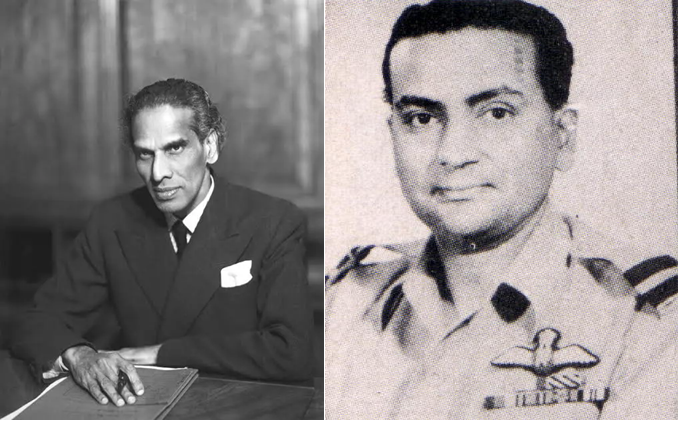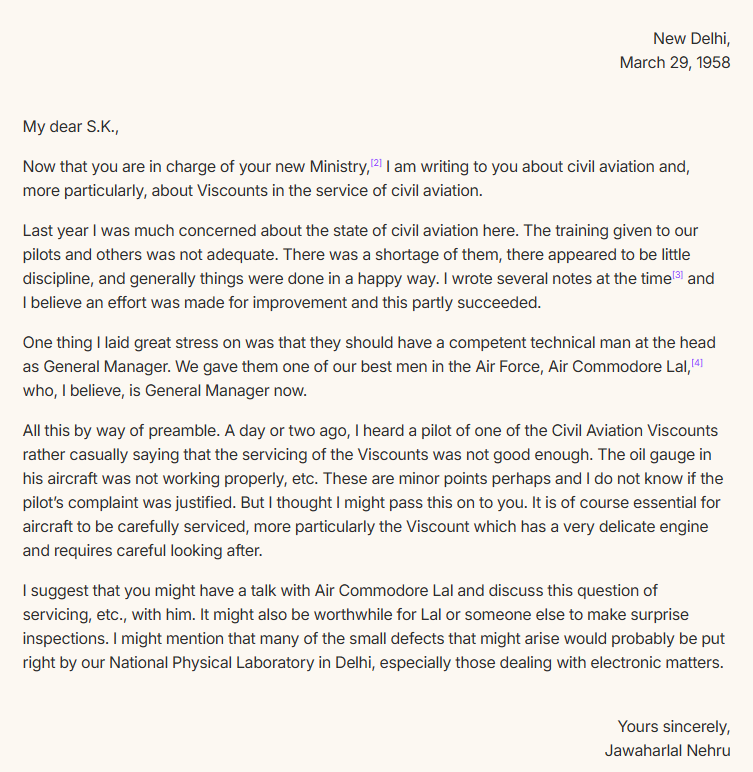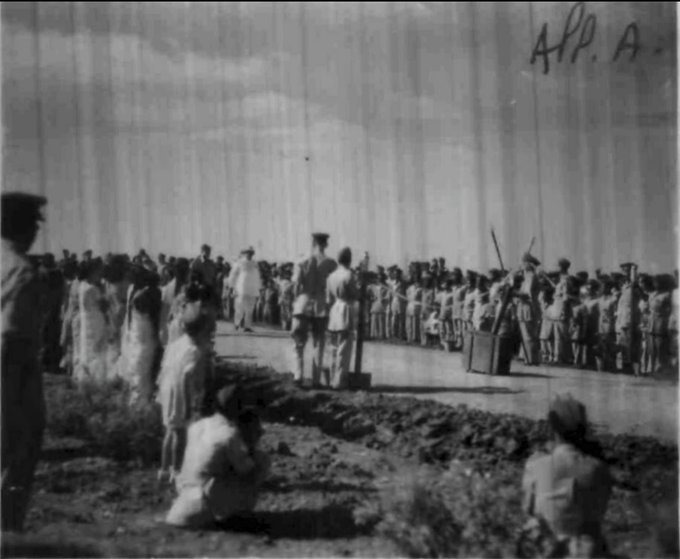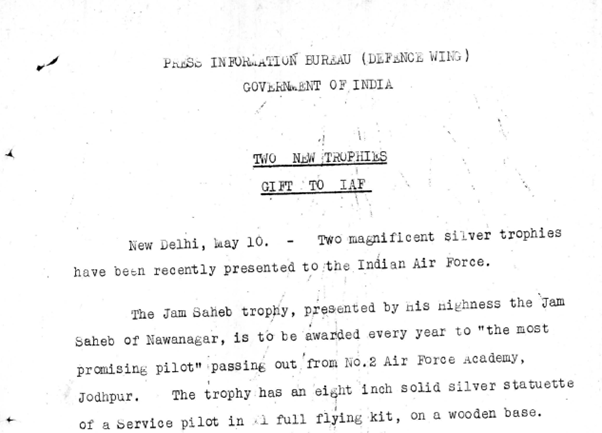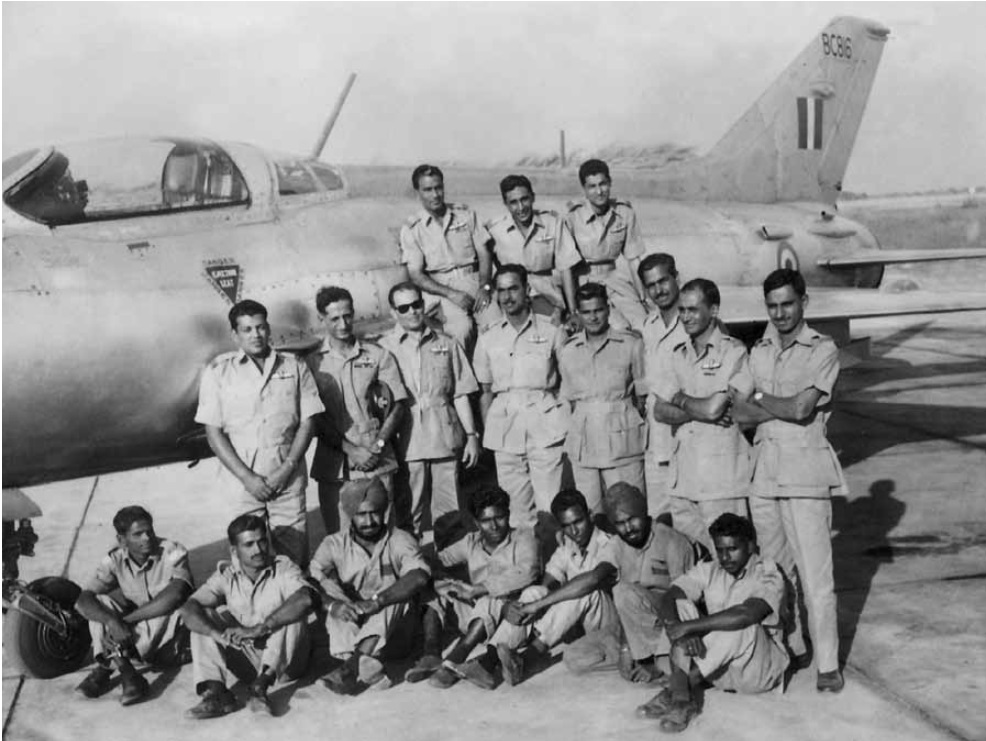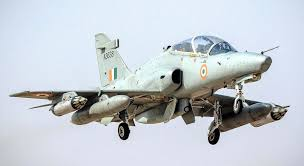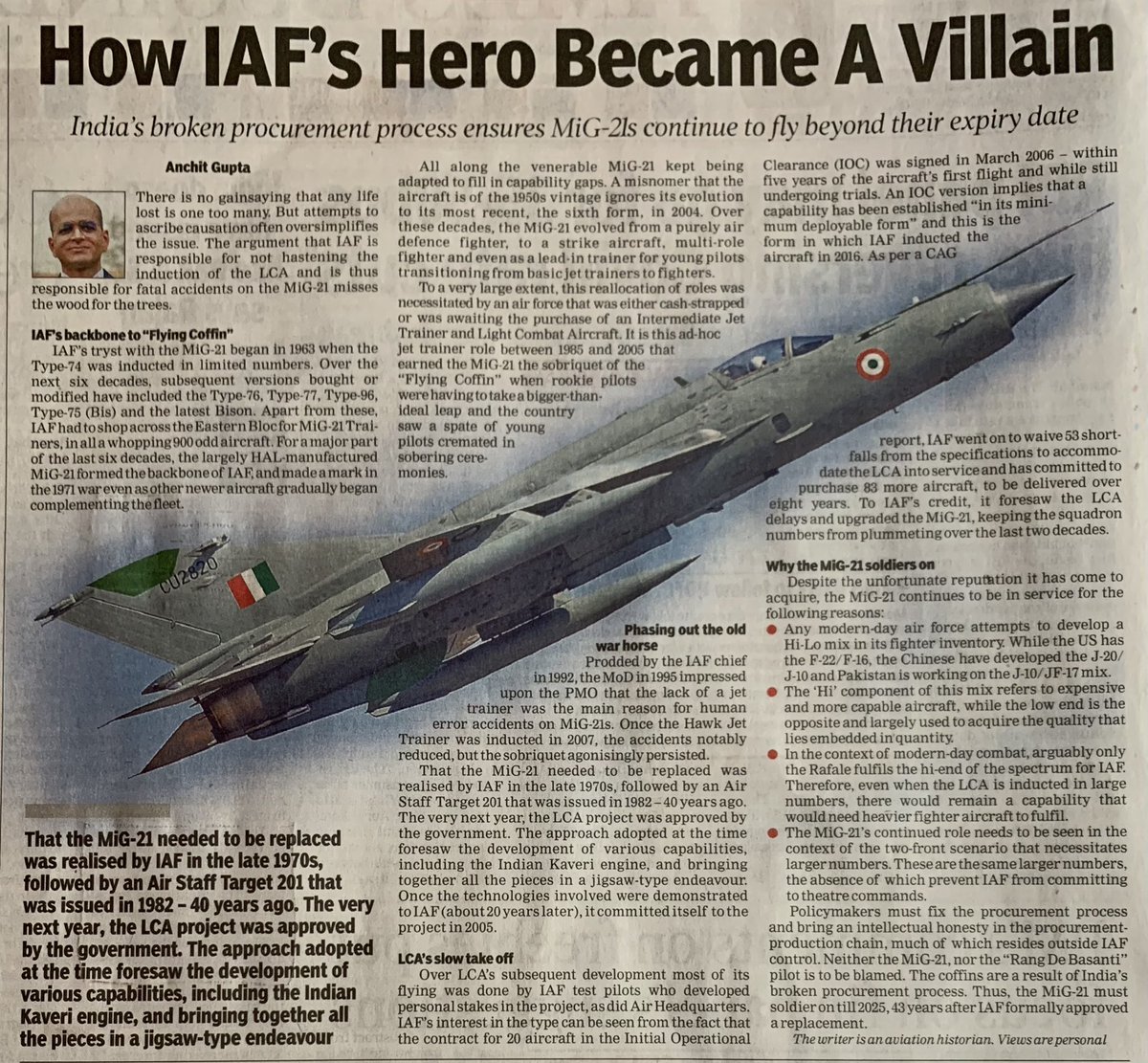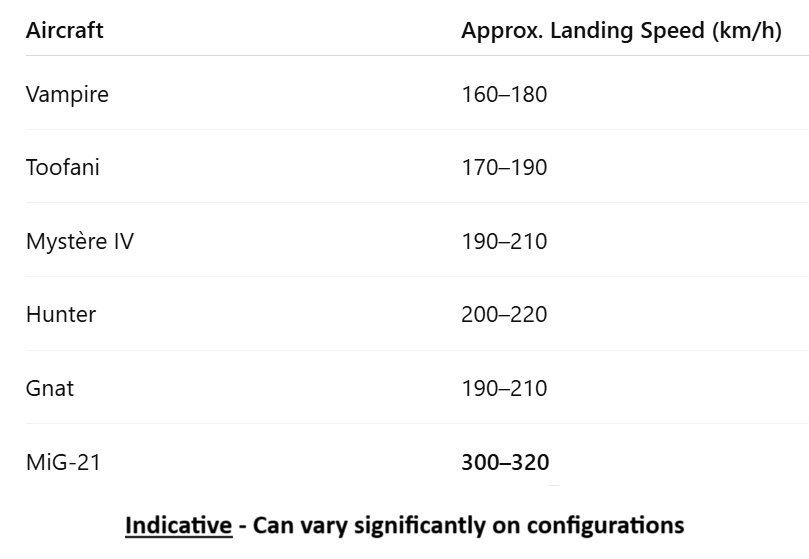@IAF_MCC Srinagar base (1 Wing) has repeatedly witnessed aerial combat in its 54 years of hosting fighter aircraft. It turns a page when 51 sqn winds down after its 37-year vigil. This thread is a chronicle of Srinagar’s unique tryst with fighter aircraft. #IAFHistory (1/30) 

In ‘47, Srinagar had a fair-weather Kutcha grass strip of 1,500 yds used for light ac of Raja Hari Singh. At partition, Kashmir’s geo-loc & ltd rail/road links isolated the valley, enhancing the importance of the airstrip- placing it at the hub of efforts to save Kashmir.2/ 

Whilst IAF ops had started in Oct 47, an IAF establishment was placed here in May ’48. Spitfires, Tempests & Harvards of 7,8,10 & 101 Sqn operated throughout the war, moving out when the UN imposed a Ceasefire in '49. The Dakota (12 Sqn) story is here -3/
https://twitter.com/anchitgupta9/status/1548525296369876992
As of ’47, IAF had 3 Wings – No. 2 (Poona), 3 (Palam) & 4 (Agra). 3 Wing's AdvHQ was located at Jammu for the ‘47 ops. In Mar ’48, 1 Wing was raised at Jammu & in May, it positioned its AdvHQ at SRI. In July ’50 1 Wing moved to Srinagar. Thus did the IAF stage its way to SRI! 4/ 

1 Wing controlled all airstrips north of & incl Pathankot, crucial to the air maint of Kashmir & Ladakh. Over the next 15 years – Daks & Packets (12, 19, 43 Sqn), Otters (41 Sqn), IL-14 (42 Sqn), Mi-4 (107, 109 HU) & Chetak (114 HU) kept the region serviced in summer & winter. 5/ 

’62 war put in motion a series of reforms. The office of AOC, J&K was created (effectively taking up the role from 1 Wing thus far) & in the years ahead 1 Wing (Srinagar), 21 Wing (Leh), 23 Wing (Jammu), 18 Wing (Pathankot) became independent establishments.6/ 

Operationally, IAF started to run trials for fighter ops at Leh to thwart the Chinese threat after the '62 war. A delicate balance where Srinagar continued to be the transport hub without any fighters per the UN resolution. 7/
https://twitter.com/AnchitGupta9/status/1495014840242302980
Despite knowing India was adhering to UN resolution, PAF attacked Srinagar base in the ’65 war that only had non-offensive assets. Sabres & B-57s stuck on multiple occasions with dozens of 1,000lb bombs destroying a Dak, damaging Mi-4s, a UN Caribou apart from damage to infra. 8/ 

A segue to the topography is relevant. Srinagar is just 40-50 km from the LoC with Pakistan, separated by the 3,000 mts high Pir Panjal range of the Himalayas. This allows intruding aircraft an element of surprise leaving barely 2-3 minutes for the defender to respond. 9/ 

IAF fighter ac had flown over Kashmir & Srinagar as a show of force/Flag. Be it the 3 Sqn Mysteres in 1965 flown by its CO Paul Robey or in 1966, 27 Sqn Hunters flying 8 ac in two boxes. But they did not land or operate at Srinagar. IAF was clearly searching for solutions. 10/ 

In June 67, Mysteres did a ground attack exercise on Srinagar. They had a free run. The base radar could not catch them due to Radar clutter from the hills. Possibly because of this outcome, IAF decided to experiment with detachments of Air Defence fighters at SRI. 11/ 

In Oct 68, Gnats of 18 Sqn (based at Ambala) became the first fighter sqn since the UN resolution to operate a 6 ac dett at SRI. Choice of Gnats was an interesting one – It was the mainstay Air Def fighter of IAF at that time, MiG-21 still being young in service. 12/ 

’65 War had confirmed the Gnats' superiority over the Sabre in aerial combat in acceleration, climb rate, maneuverability & turning radius. The diminutive Gnat was difficult to spot, let alone hit during combat. By now IAF had 5 Sqns on the type – 2,9,18,21 & 22 Sqn 13/ 

But the most imp factor in favour of Gnat for the defence of SRI, was its extremely fast scramble time (airborne in under 2 mins) during ORP (operational readiness Platform). This was the only somewhat neutralising factor to the surprise element PAF held across the Pir Panjal.14/ 

As the war clouds built up, 18 Sqn pos a dett at SRI in Aug 71. SRI by now was 3,500-yard-long runway, with a parallel taxi track, but only a few Blast Pens, limiting it to 4-ac ops. There was no Radar & winter visibility in the Valley is extremely poor due to mist/fog. 15/ 

The only warning was scattered obs posts (OP) that provided vis inputs, often too late. 18 Sqn dett role was the protection of the base (ORP + Combat Air Patrol) & to provide AD cover to a dett of Vampire a/c (122 Ad-Hoc sqn). The dett had 4 ac and 13 pilots. 16/ 

On 6 Dec, with 4 Sabres attacking, dusk CAP of VS Pathania & Bopaiah engaged in a dogfight in the middle of own ack-ack fire. In a posn for kill, Pathania’s gun jammed just after a few hits. After seeing the Sabre flee, he landed back in failing light on a damaged RW. 17/ 

On 14 Dec 71, 0802 a warning came & just as Ghuman and Sekhon were getting airborne at 0804, PAF Sabres bombed the runway. An epic dogfight ensued in which Sekhon was awarded PVC Posthumously. Air combat is most accurately described here 18/
SRI was subject to 12+ day-light raids by PAF. SRI had proved that when the elements came together, it could offer the best of aerial combat from both sides. Despite handicaps, the Gnats had managed to thwart PAF. But it was clear, that a lot more was needed to safeguard SRI 19/ 

After ’71, the Simla agreement was signed & India chose to base fighters in Kashmir. Summer of 72, SRI was a fighter town – Gnats, Hunters & MiG-21s running concurrent detts. By ’75, it was decided to permanently have 2 Gnat Sqns & make SRI a fighters-only base.20/ 

SRI beefed up Air Defence in the 70s. All elements of Air Def viz, Base Radar, SAMs, Observation flights were in place by ‘76. Awantipur, ~25 km from Srinagar, an airstrip made in 66 but in disuse, was also activated in 76 as a satellite airfield. SRI now had mutual AD cover. 21/ 

By mid-80s, the homegrown HAL Ajeet was in its twilight yrs. A replacement was needed. The only other a/c in the IAF inventory that was capable of a fast scramble was the MiG-21. In May 86, the recently raised Swordarms (51 Sqn), flew in with MiG-21 bis from Chandigarh. 22/ 

Op Brasstacks in ’87 tested preparedness. 51 Sqn carried out intensive valley flying & manned ORPs at both SRI & Avantipur thru a 3-month pd. Subsequently, MIG-29s of 28 Sqn, MiG-27 of 222 Sqn also operated detts. Next few yrs saw more AD muscle - Igla Flt, another SAM Sqn.23/
Radars in mountains is a tough challenge. Getting a P-18/P-12 radar to Razdan pass while commendable had little benefit coz of continued hill clutter, but this was resolved successfully at a new location by ‘93. In radar battles - equally daunting tasks were taken up by PAF. 24/ 

During the Kargil conflict, SRI became the centre of IAF Ops with 5 fighter Sqns. For the 3rd time, it was being used for Strike/ Army Co-operation – 47 War (Tempests/ Spitfires), 71 War (Vampire/T-6G), and now MiG-21/23/27. 25/
https://twitter.com/AnchitGupta9/status/1492080947495411727
51 Sqn also had a go at Pt 5140 & Tololing in the 1st 2 days of the Op with rockets, reverting to its primary AD role & ORPs at SRI & Awantipur. They would fly over 100 sorties & earn four gallantry awards during the op. Entrepreneur @joe_sameer has a tale to tell here. 26/ 

SRI again came close to witnessing an aerial Combat when MiG-21s of 51 Sqn & MiG-29s of 223 Sqn were on hunter-killer missions to bait PAF fighters operating out of Skardu in early June ’99. PAF did not pick up the gauntlet, keeping to itself during the conflict. 27/ 

51 Sqn upgraded to MiG-21 bison in ’04, bringing BVRs to the valley. This capability proved crucial in ‘19 when 51 Sqn scrambled & the skies over Pir Panjal witnessed aerial combat after 48 years. This time, MiG-21 vs F-16 had replaced Gnat Vs Sabres. 28/ 

Flanked by our two probable adversaries, it is likely that any future conflict could see contrail circles mar the clear azure skies over the region as the baton of being the Vale's defenders passes on. 51 Sqn & its steed have earned a well-deserved rest…for now.
Gar Fidaus…29/
Gar Fidaus…29/

A loud shout out to @Sauravchordia1 & @zone5aviation for the fantastic aviation shots and help with graphics that bring the narrative to life. (30/30)
• • •
Missing some Tweet in this thread? You can try to
force a refresh


